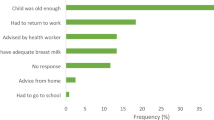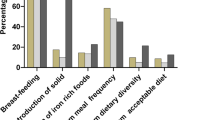Abstract
Objective:
Few published data are available on the feeding practice of younger children in Tibet. Our study investigated feeding pattern of younger Tibetan children.
Design and subjects:
The study was a cross-sectional survey conducted in Tibet. A sample of 1655 children younger than 36 months old and their mothers was obtained by stratified multistage cluster random sampling method. Mothers were interviewed to collect information on feeding practice by a designed family questionnaire including initial time and duration of breastfeeding and time, frequency and types of complementary foods introduced.
Results:
Most of the children was ever or being breastfed at the time of interview. The median duration of breastfeeding was 26 months. The prevalence of almost exclusive breastfeeding for 4 months was 20.1%. Mothers' age and education, child's residence, and introduction of egg, fresh milk and milk powder were strongly associated with the duration of breastfeeding. The partial feeding was a main pattern in the first 6 months of life. Zanban and porridge were offered at about 1 month after birth. By 6th month, less than 25% of children were fed protein foods such as egg and meats and only near 20% of children were fed fresh vegetables. Bean products, fish and chicken were seldom offered to children.
Conclusions:
We conclude that although they were breastfed for long time, complementary feeding practice of Tibetan children was disadvantaged, especially of rural children. Improvement of monotonous complementary foods and timely introduction should be stressed in local programmatic nutritional interventions.
This is a preview of subscription content, access via your institution
Access options
Subscribe to this journal
Receive 12 print issues and online access
$259.00 per year
only $21.58 per issue
Buy this article
- Purchase on Springer Link
- Instant access to full article PDF
Prices may be subject to local taxes which are calculated during checkout


Similar content being viewed by others
References
Brown KH, Black RE, Lopez de Romaña G & Creed de Kanashiro H (1989): Infant feeding practices and their relationship with diarrheal and other diseases. Pediatrics 83, 31–40.
Brown KH, Dewey KG & Allen LH (1998): Complementary Feeding of Young Children in Developing Countries: A Review of Current Scientific Knowledge. Geneva, Switzerland: World Health Organization.
Cohen RJ, Brown KH, Canahuati J, Riviera LL & Dewey KG (1994): Effects of age of introduction of complementary foods on infant breast milk intake, total energy intake, and growth: a randomised intervention study in Honduras. Lancet 344, 288–293.
Dang S, Yan H, Yamamoto S, Wang X & Zeng L (2004): Poor nutritional status of younger Tibetan children living at high altitudes. Eur. J. Clin. Nutr. 58, 938–946.
Dewey K, Cohen R, Brown K & Rivera L (1999): Age of introduction of complementary foods and growth of term, low-birthweight, breast-fed infants: a randomized intervention study in Honduras. Am. J. Clin. Nutr. 69, 679–686.
Dewey K, Cohen R, Rivera L & Brown K (1998): Effects of age introduction of complementary foods on iron status of breast-fed infants in Honduras. Am. J. Clin. Nutr. 67, 878–884.
Fu Z, He W & Chen C (2000): Relationship between growth of young children and complementary feeding. Wei. Sheng. Yan. Jiu. 29, 279–282.
Haider R, Islam A, Kabir I & Habte D (1996): Early complementary feeding is associated with low nutritional status of young infants recovering from diarrhoea. J. Trop. Pediatr. 42, 170–172.
He YN & Zhai FY (2001): Complementary feeding practice in Chinese rural children. Wei. Sheng. Yan. Jiu. 30, 305–307.
Hornell A, Hofvander Y & Kylberg E (2001): Solid and formla: association with pattern and duration of breastfeeding. Pediatrics 107, http://www.pediatrics.org/cgi/content/full/107/3/e38, (accessed May 15, 2003).
Liu R (1988): China Population, Section of Tibet. Publishing House of Finance and Economy, Beijing.
Liu YL, Ling LM, Zhang XL & Shang Q (2001): Analysis on the status of supplementary food among infants in China. China J. Child Health Care 9, 361–363.
National Working Committee on Children and Women (2001): Report of the People's Republic China on the Development of Children in the 1990s. Beijing, pp. 32–33.
Oddy W, Holt P, Sly P, Read A, Landau L, Stanley F, Kendall GE & Burton PR (1999): Association between breast feeding and asthma in 6 year old children: findings of a prospective birth cohort study. BMJ 319, 815–819.
Piwoz EG, Creed de Kanashiro H, Lopez de Romana GL, Black RE & Brown KH (1996): Feeding practices and growth among low-income peruvain Infants: a comparison of internationally-recommended definitions. Int. J. Epidemiol. 25, 103–112.
Popkin BM, Adair L, Akin JS, Black R, Briscoe J & Flieger W (1990): Breast-feeding and diarrheal morbidity. Pediatrics 86, 874–882.
Prentice A (1994): Extended breast-feeding and growth in rural China. Nutr. Rev. 52, 144–146.
Research Working Group on Growth and Development of Children in 9 Municipal Areas (1996): The Survey and Study on Development of Children, Ages 0–84 months, Living in 9 Municipal Areas. Publishing House of Beijing Medical University, Beijing.
Ruel MT & Menon P (2002): Child feeding practices are associated with child nutritional status in Latin America: innovative uses of the demographic and health surveys. J. Nutr. 132, 1180–1187.
Simondon KB & Simondon F (1997): Age at introduction of complementary food and physical growth from 2 to 9 months in rural Senegal. Eur. J. Clin. Nutr. 51, 703–707.
World Health Organization (1998): Complementary Feeding of Young Children in Developing Countries: A Review of Current Scientific Knowledge. Geneva: World Health Organization (WHO/NUT/98.1.
World Health Organization (2002): Report of Expert Consultation on the Optimal Duration of Exclusive Breastfeeding. Geneva: WHO/NHD/CAH.
Zeng LX, Yan H, Guo X, Dang SN & Xie H (2002): Analysis on feeding patterns and factors affecting feeding patterns of children under 3 years old in 40 rural counties in western China. J. Xi'an Jiaotong Univ. (Med. Sci.). 23, 600–604.
Acknowledgements
We thank the women and their children participated in our survey. We thank Minister of Health, People's Republic of China, and Untied Nations Children's Fund for support and cooperation; Minster of Health, Tibet and local health bureau and MCH stations of Lhasa, Nyingchi, Xigaze, Lhokha, Chamdo, Nagchu and Ngari districts for cooperation and organization in the field data collection; and staff from MCH stations and Xi'an Jiaotong University for participation in the field data collection. We thank especially Dr. Ray Yip, UNICEF, Beijng and Professor Zhonghui Feng, former director of Faculty of Public Health, Xi'an Jiaotong University for their constructive suggestions in the preparation of research protocol and data collection and processing. We also thank Quangli Wang, Yuxue Bi, Hong Xie, Qiang Li, Shengbin Xiao for data arrangement and entry.
This work was sponsored and funded by the Ministry of Health, People's Republic China and Untied Nations Children's Fund (UNICEF).
Author information
Authors and Affiliations
Corresponding author
Additional information
Guarantor: H Yan.
Contributors: SD was involved in the preparation of the research protocol, field management, collection and analysis of data and manuscript writing. HY was responsible for the design of research and sampling, field management and preparation of protocol. SY provided significant advices, consultation and guide on the data analysis and interpretation and manuscript writing. XW provided important advices on the design of research and collection of data. LZ was involved in the preparation of survey and data of analysis.
Rights and permissions
About this article
Cite this article
Dang, S., Yan, H., Yamamoto, S. et al. Feeding practice among younger Tibetan children living at high altitudes. Eur J Clin Nutr 59, 1022–1029 (2005). https://doi.org/10.1038/sj.ejcn.1602207
Received:
Revised:
Accepted:
Published:
Issue Date:
DOI: https://doi.org/10.1038/sj.ejcn.1602207
Keywords
This article is cited by
-
The Growth Pattern of Tibetan Infants at High Altitudes: a Cohort Study in Rural Tibet region
Scientific Reports (2016)
-
Mountain Child: Systematic Literature Review
Maternal and Child Health Journal (2016)
-
Maternal and child health in Yushu, Qinghai Province, China
International Journal for Equity in Health (2011)
-
Nutrient intakes of rural Tibetan mothers: a cross-sectional survey
BMC Public Health (2010)



